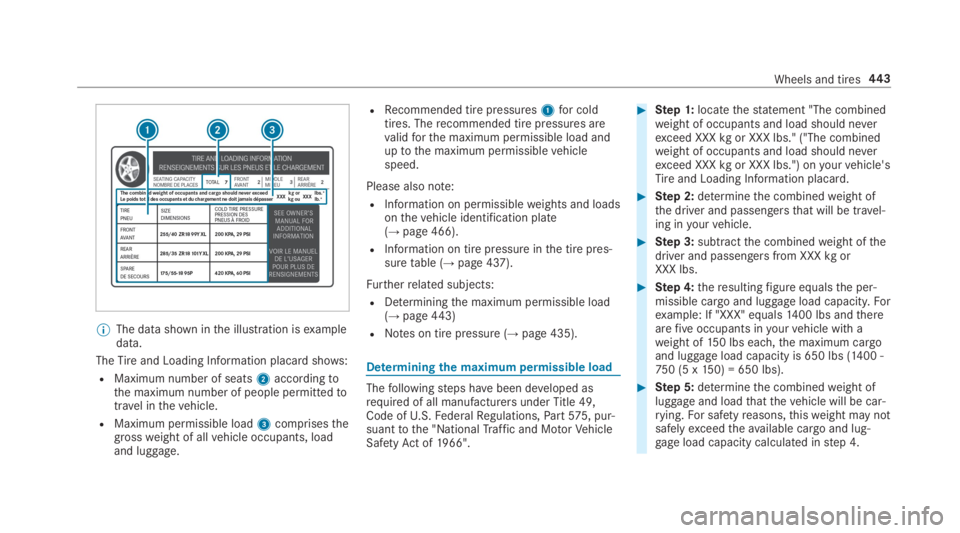tyre pressure MERCEDES-BENZ S CLASS 2019 Owners Manual
[x] Cancel search | Manufacturer: MERCEDES-BENZ, Model Year: 2019, Model line: S CLASS, Model: MERCEDES-BENZ S CLASS 2019Pages: 578, PDF Size: 23.31 MB
Page 421 of 578

#Toreduce the tire pressure:press pressurerelease button1nexttopressuregauge2.
#Whenthe tire pressure is correct, unscrewthefilling hose fromthevalve ofthe sealedtire.
#Screwthevalve cap ontothevalve ofthesealed tire.
#Pullthe tire sealant bottle out ofthe tireinflation compressor.Thefilling hosestays onthe tire sealant bot‐tle.
#Drivetothe nearestqualified specialistwork‐shop and havethe tire, tire sealant bottle andfilling hosereplacedthere.
Battery(vehicle)
Notes onthe12V battery
&WARNINGRisk of an accident duetoworkcarried out incorrectly onthe bat‐tery
Workcarried out incorrectly onthe batterycan,forexample, leadtoa short circuit. Thiscan leadtofunctionrestrictions in safety-rel‐evant systems,forexamplethe lighting sys‐
tem, ABS (anti-lockbraking system) or ESP®
(ElectronicStability Program). The operatingsafety ofyourvehicle may berestricted.
You could lose control ofthevehicle inthefollowing situations:
Rwhen braking
Rintheevent of abruptsteering maneuversand/or whenthevehicle's speed is notadaptedtotheroad conditions
#Intheevent of a shortcircuit or a simi‐lar incident, contact aqualified special‐istworkshop immediately.
#Do not continue driving.
#Always haveworkonthe battery carriedout at aqualified specialistworkshop.
RFurther information on ABS (→page192)
RFurther information on ESP®(→page193)
For safetyreasons, Mercedes-Benzrecommendsthatyou onlyuse batteries which havebeentes‐ted and approvedforyourvehiclebyMercedes-Benz. These batteries provide increased impactprotectiontopreventvehicle occupants fromsuffering acid burns shouldthe battery be dam‐aged intheevent of an accident.
Breakdown assistance419
Page 445 of 578

%The data shown inthe illustration isexampledata.
TheTireand Loading Information placard shows:
RMaximum number of seats2accordingtothe maximum number of people permittedtotravel inthevehicle.
RMaximum permissible load3comprisesthegrossweight of allvehicle occupants, loadand luggage.
RRecommended tire pressures1for coldtires. Therecommended tire pressures arevalidforthe maximum permissible load anduptothe maximum permissiblevehiclespeed.
Please also note:
RInformation on permissibleweights and loadsonthevehicle identification plate(→page 466).
RInformation on tire pressure inthe tire pres‐suretable (→page 437).
Furtherrelated subjects:
RDeterminingthe maximum permissible load(→page443)
RNotes on tire pressure (→page 435).
Determiningthe maximum permissible load
Thefollowingsteps havebeen developed asrequired of all manufacturers underTitle 49,Code ofU.S.FederalRegulations,Part575, pur‐suanttothe "NationalTraffic and MotorVehicleSafetyAct of1966".
#Step 1:locatethestatement "The combinedweight of occupants and load should neverexceed XXXkgor XXX lbs." ("The combinedweight of occupants and load should neverexceed XXXkgor XXX lbs.") onyourvehicle'sTireand Loading Information placard.
#Step 2:determinethe combinedweight ofthe driver and passengersthat will be travel‐ing inyourvehicle.
#Step 3:subtractthe combinedweight ofthedriver and passengers from XXXkgorXXX lbs.
#Step 4:theresultingfigure equalsthe per‐missible cargo and luggage load capacity.Forexample: If "XXX" equals1400 lbs andtherearefiveoccupants inyourvehicle with aweight of150 lbs each,the maximum cargoand luggage load capacity is 650 lbs (1400 -750 (5 x150) = 650 lbs).
#Step 5:determinethe combinedweight ofluggage and loadthatthevehicle will be car‐rying.For safetyreasons,thisweight may notsafelyexceedtheavailable cargo and lug‐gageload capacity calculated instep 4.
Wheels and tires443